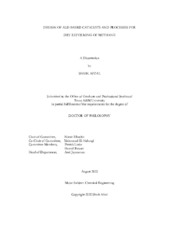| dc.description.abstract | Dry reforming of methane (DRM) is an important process that utilizes CO2 to convert methane into a mixture of H2 and CO (synthesis gas or syngas). Commercial applicability of DRM has been challenged by the high energy requirement, susceptibility to coke formation, and low-quality syngas (syngas ratio, H2/CO ~ 1). In this work, a multi-scale approach is used to address each of these challenges in a systematic way.
A commercial 20% nickel-based catalyst is used as a benchmark, and the performance of all synthesized catalysts is compared with this benchmark catalyst. Atomic Layer Deposition (ALD) is used to deposit alumina over Ni catalysts to improve the coking and sintering resistance. In the first part of the catalysis work, the performance of commercial catalyst overcoated with 5 cycles of ALD alumina was compared with the uncoated commercial catalyst. Throughout 40 h time-on-stream, the rate of drop in catalyst dispersion was much lower in the 5-ALD catalyst when compared to the uncoated catalyst. Without sacrificing catalytic activity, the amount of coke formation in the 5-ALD catalyst decreased by 50%. In the second part of the catalysis work, pretreatment methods are investigated to modify the overcoat properties. The protocol described could be used to modify/synthesize reforming catalysts through ALD with tunable properties.
Having an efficient catalyst for DRM is not the only challenge for its industrial applicability. To better understand the impact of DRM on the reduction of carbon footprint and process economics, a Life Cycle Analysis (LCA) study was conducted. An optimization based approach is used to compare the carbon footprint of conventional reforming technologies with other processes involving DRM to produce syngas of different H2/CO ratios. Technical, economic, and environmental metrics are used to evaluate processes that can utilize the varying H2/CO ratio of syngas, and promising pathways are highlighted. This multi-scale work has identified treatment techniques for ALD catalysts and modifications to the DRM process that hold potential for the future, both in terms of reducing the overall carbon footprint and operating costs of syngas production. | en |


